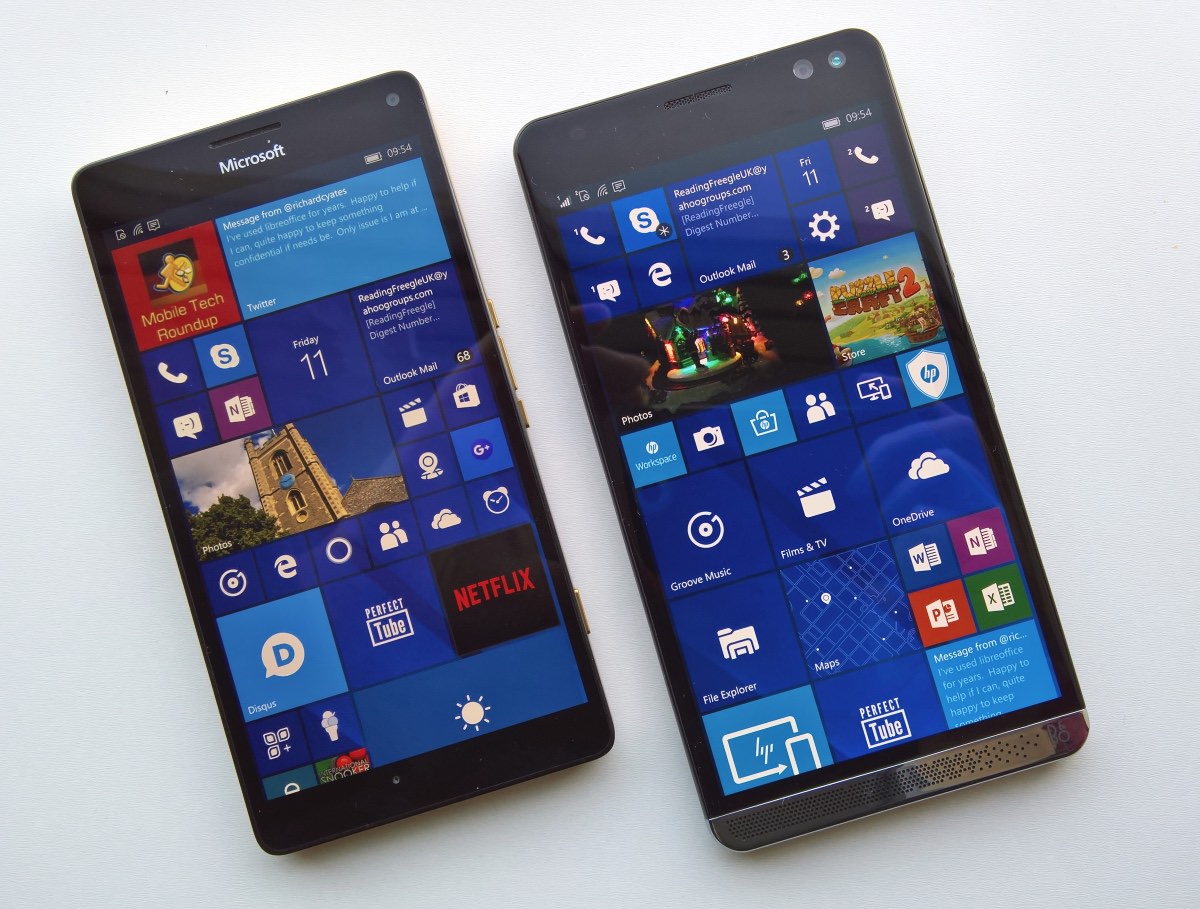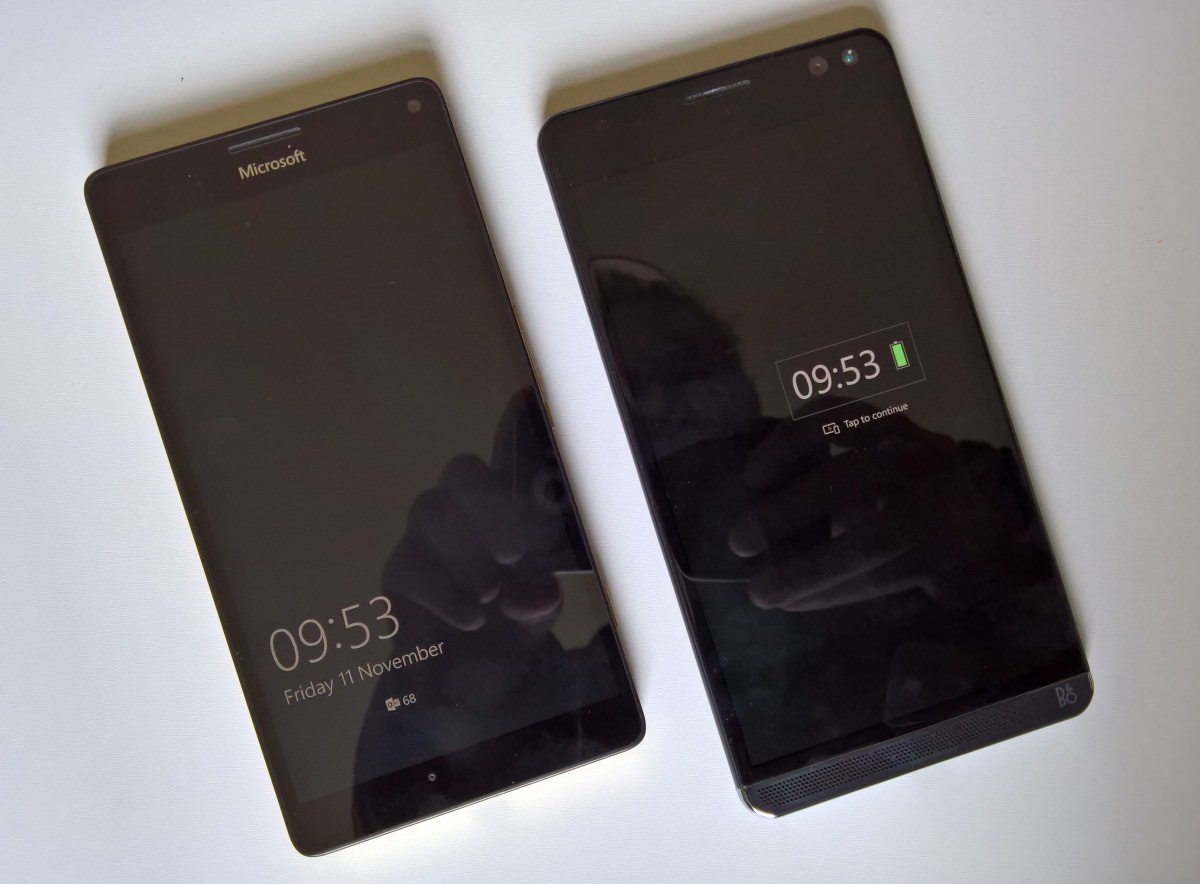
Lumia 950 XL and HP Elite X3, each with Windows virtual controls swiped away, showing the full extent of their displays.
______________________________________________
As usual, I've shaded in green an obvious 'win' for either device, I honestly have no idea which way this one's going to go (as I start to compile the feature)... Any row where a winner would be totally subjective is left uncoloured. Or, where both devices are utterly excellent but in different ways, I've given both a 'green'(!)
[By the way, if you're viewing this feature on (ironically) a smaller-screened Windows Phone then the table may well cause you problems. Try viewing in landscape mode? Failing that, go view this on a laptop or tablet and then roll on Windows 10 Mobile across the board on all the older phones!]
| HP Elite X3 | Microsoft Lumia 950 XL | |
| Date first available | September 2016 | November 2015 |
| Current price, availability | £700 (SIM-free in the UK, inc VAT - from Clove - and including Continuum Desk Dock and various adapters and cables). Other prices and bundles available, according to country. | £340, SIM-free, from Amazon UK, all 950 XL models still qualify for the free Continuum Dock, in theory, though availability is up in the air, depending on where you are in the world, I suspect. |
| Dimensions, form factor, weight |
162 x 83 x 8mm, heavy duty plastic body and frame, 195g.
|
152 x 78 x 8mm, plastic chassis and replaceable backs (plastic/leather/wood etc, from Mozo), 165g |
| Durability | IP67 for liquid and dust, plus mil-spec drop and shock resistance, thanks to the use of shock-absorbing plastics rather than metal. | No specific durability metrics, though the fact that the back comes off will help enormously for water damage, i.e. taking out battery and cards immediately, drying out the internals. Damage to the back or corners is trivial through replacement, but the screen's exposed, of course. |
| Operating system, interface | Windows 10 Mobile, (dismissable) virtual controls |
The same, obviously - Windows 10 Mobile, (dismissable) virtual controls |
| Display | 5.96" AMOLED QHD (1440p), Gorilla Glass 4, quasi-always-on glance display available via HP Display Tools - see the bonus photo at the bottom(!) | 5.7" AMOLED QHD (1440p), Gorilla Glass 4, ClearBlack Display polarisers help with outdoor contrast, Glance screen available (in various colours) for always-on time, day and notification icons |
| Connectivity | LTE up to 600Mbps, plus dual nano SIM (if microSD unused), NFC, Wi-Fi b/g/n/ac, integral wifi tethering, Bluetooth 4.2, Continuum connectivity to use external displays as secondary screen, independent of the phone display | LTE up to 300Mbps (all bands), NFC, Wi-Fi b/g/n/ac, integral wifi tethering, Bluetooth 4.2, same Continuum connectivity just as with the X3 |
| Processor, performance | Snapdragon 820 chipset, 4GB RAM (of which 3.5GB are used directly), in theory very fast indeed - though it's still not clear how much the OS and firmware have been optimised for it yet - see the comment and link on the right. | Snapdragon 810 chipset, 3GB RAM, in practice, faster than the Elite X3 currently for some things, though the latter will get faster with updates. |
| Capacity | 64GB, expandable via microSD | 32GB internal storage, expandable via microSD |
| Imaging (stills) |
13MP (currently, ignore what you've read about 16MP) f/2.2, single LED flash, HDR shots, PDAF in theory, but waiting on a firmware update. Decent shots in most light conditions, though ultimately limited. See here for my full Elite X3-Lumia 950 XL shootout. 8MP front camera |
20MP PureView f/1.9 1/2.4" BSI sensor, Phase Detection auto-focus, dedicated camera shutter button and launch key, genuine 2x lossless digital zoom (in 8MP oversampled mode), OIS. 'Rich Capture' produces customisable HDR shots and 'dynamic flash', with triple LED illumination. Outstanding shots in most light conditions, with just focussing issues in low light as an Achilles heel. 5MP front camera
|
| Imaging (video) | 4K, optionally digitally stabilised, with 'Best photo' 8MP grabbing built-in, plus stereo audio recording (though limited to mono in current firmware) | 4K, optically (and optionally digitally) stabilised, with 'Best photo' 8MP grabbing built-in, plus Rich Recording and quad HAAC microphones for high quality stereo capture. |
| Music and Multimedia | Decent front-facing stereo speakers, though very weak in terms of bass frequencies (surprising, given the B&O branding, it's possible that there are optimisations yet to come). Perhaps optimised for the human voice, i.e. speakerphone use? 3.5mm headphone jack, A2DP | Decent mono speaker, loud but lacking in bass and depth, though you can trade volume for fidelity in a simple tweak. 3.5mm headphone jack, A2DP+APT-X, so superior headphone audio, but it can't make up for the weedier speaker overall. |
| Navigation | Windows 10 Maps is comprehensive, has a degree of live traffic awareness, plus public transport. Includes full offline maps with automatic updates. |
Ditto. Pretty impressive, though one rung down from Google Maps in terms of live traffic awareness and re-routing. |
| Cortana/Voice | Cortana is now mature and well integrated, and with a surprising degree of 'assistance'. | Ditto, Cortana is up with the best of the AI assistants in the tech world. |
| Battery, life | Sealed 4150mAh battery, gets through two days of use, plus USB Type C fast charging (up to 2A) and compatibility with Qualcomm's Quickcharge 3.0. Plus Qi (and PMA) wireless charging built-in. | Removable 3300mAh battery, easily gets through a day (on latest firmware), plus USB Type C (up to 3A) and Qi wireless charging built-in. |
| Cloud aids | Windows Photos syncs across all signed-in devices, subject to your OneDrive tariff, should you have thousands of images in the system. Plus Windows 10 backs all your media, application data and settings to a separate backup folder system, tariff-free on OneDrive. | Ditto, Windows 10 Photos works really well, helped by a decent chipset on these devices to plough through hundreds of thousands of thumbnails! |
| Biometrics | Iris recognition ('Windows Hello') works well unless you wear varifocals(!), but takes a few seconds in real world use, while the fingerprint sensor is effectively instant though in practice the 'Hello' animation takes a second, so....! | Reliant on just the iris scanner - it works but is hardly the quickest or most convenient way to authenticate. |
| Applications and ecosystem | Windows 10 Mobile now has just about every mainstream app covered, aside from Snapchat and Tinder. And anything to do with Google services! The idea with the Elite X3 though is to have professional application suites like Office, Outlook, Salesforce, and many more, plus the option of a paid/managed virtual Win32 desktop through Continuum and HP Workspace. | Exactly as for the Elite X3, the two are 100% equivalent at the Windows 10 Mobile software level. I doubt anyone's tried dialling into HP Workspace using a Lumia but of course it should work in theory. In practice, you'd probably use the Remote Desktop application as an individual or small business owner. |
| Upgrades and future | Windows 10 Mobile will be updated through 2017, of course, as part of the global Windows 10 ecosystem. Production devices can expect updates every month, Insiders every few weeks. The X3 is part of the Insider program if needed. | Ditto, the next major update is in Spring 2017 and is dubbed the 'Creators Update'. Not that it affects the phone too much, other than fixing bugs under the hood and improving general performance. |
Verdict
Adding up the green 'wins' gives the HP Elite X3 the victory by 6-4, which also summarises how I feel about the two devices after significant use. At a pinch I'd take the HP Elite X3 if offered both phones for the same money, though I admit that I'd be torn, since the Lumia 950 XL's wins (mainly imaging) are big, while the X3 simply presents as a more powerful and more rugged powerhouse and with hopefully better support from a more committed (to hardware) company.
Again I have to emphasise that the Elite X3 comes into the smartphone market at one end, diametrically opposite the likes of the Apple iPhone and cheap and cheerful Android handsets, while the Lumia 950 XL tries to fit in with both consumer and business requirements. So the two super-phones here aren't really competitors, other than running the same OS and both majoring on their Continuum chops.
As AAWP readers and enthusiasts though, which way would you fall on the two device above? I've already heard from a number of readers who have bought the Elite X3 for their own personal (and presumably professional) use and who are, on the whole, pretty happy.
PS. See also my HP Elite X3 review series, starting here.

From the rear, here with the Lumia 950 XL wearing an eye-catching red leather Mozo back cover.

OK, so I'm cheating here a little - the HP Elite X3 doesn't have traditional Glance screen, i.e. it doesn't automatically come on unless you're connected to a Continuum display. However, the HP Display Tools screensaver here is easy to run manually whenever you like. And it's (naturally) brighter than the semi-permanent Glance screen arrangement on the Lumia, so it moves around the screen as needed, to prevent burn-in...
